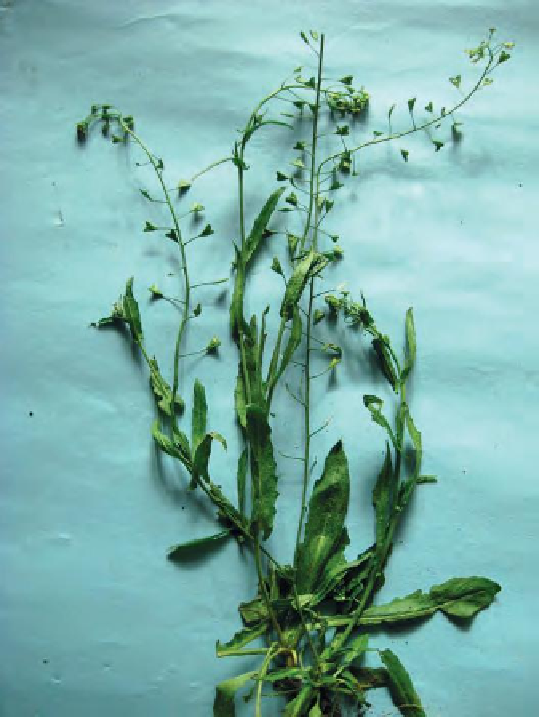Agriculture Reference
In-Depth Information
may be infected by cucumber mosaic virus carried by
peach-potato aphid (see p. 230).
Control
. Chickweeds are controlled by a combination
of methods.
Physical
controls include partial
sterilization of soil in greenhouses, while the
cultural
control
of hoeing in the spring and autumn periods
prevents the developing seedling from developing and
flowering. Mulching is effective against germinating
weeds. Gardeners can use the non-selective, non-
persistent herbicide
glyphosate
for control in such
situations as ornamental beds containing woody
perennials, and in cane fruit, but care is needed to
avoid spraying foliage of garden plants.
Mouse-eared chickweed in turf is reduced by mowing
the grass close to the ground, by the
cultural
control
method of raking out the weed's horizontal stems in
spring, and by seeding over bare areas in spring or
autumn with grass varieties that are suitable for the
growing situation. Herbicides containing a combination
of active ingredients such as
clopyralid
,
2,4-D
,
MCPA
may be effectively used against mouse-eared
chickweed (as a spot spray or over the whole area)
when it is growing in turf.
Shepherds's purse (
Capsella
bursa-pastoris
)
Damage and location
. This is an annual (and biennial)
weed (Figure 17.10) that is commonly found in
gardens, and other cultivated and wayside locations,
and is found growing on most soil types, sometimes
in large numbers. It has been recorded in up to
1,750 ft in Britain and Ireland.
Life cycle
. Flowering and seed production occur
throughout the year, most commonly in May to
October. Plants can produce several thousand seeds.
Three generations of weed may occur per year.
Most seeds germinate after a 'maturation period' of
two years, but this period is much shorter in some
instances, especially when seeds are on the soil
surface and exposed to daylight. Turning-over soil
can result in dormant seeds (from a deeper level)
germinating at the soil surface. Shepherd's purse is a
host of two important diseases,
club root
and
white
blister 'rust
', and the pest
mealy cabbage aphid
.
Spread
.
The weed can be introduced, as seed, into
the garden through garden compost, or on new plants
purchased from nurseries or garden centres. It can
spread from neighbouring gardens.
Control
.
Several
cultural
methods are available for
control. Young plants can be pulled out by hand.
Seedlings can be hoed when the soil surface is dry.
Avoid disturbing the soil so that dormant seeds are
Figure 17.10
Shepherd's purse plant showing typical
small white fl owers and heart-shaped fruits
not brought to the surface.
Mulch
around garden
perennials, using a 5 cm thick layer of composted bark
or garden compost to inhibit the weeds' germination
and subsequent growth. Spraying young weeds with
a translocated weedkiller such as
glyphosate
will be
effective; but great care must be taken that the spray
does not reach garden plants.
Groundsel (
Senecio vulgaris
)
This belongs to the Asteraceae (Compositae) plant
family.
Damage and location
. This is a very common and
important weed, particularly on heavy soil. Its high
level of seed production and the ability of its seed to
germinate soon after dispersal from the plant lead to
dense mats of the weed. It grows on both rich and
poor soils up to almost 600 m in altitude. It can be a
problem in the garden, in soft fruit and in herbaceous
and woody perennials, but is most commonly serious
after soil cultivation in vegetable plots.
Life cycle
. The seedling cotyledons are narrow,
purple underneath, and the first true leaves have

